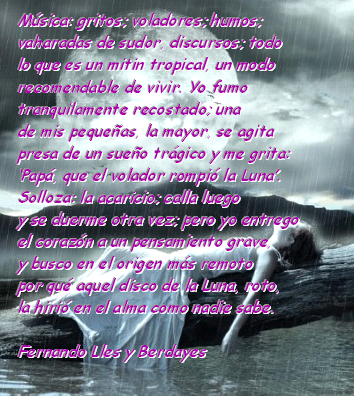4.4.3 The essay work of Fernando Lles y Berdayes (1883 – 1949)

From an ideological point of view, Fernando Lles’ essayistic work belongs to the period of republican frustration, where the established political system did not correspond to the independence ideal but to the requirements of the imperial development of the United States. The island’s own subaltern condition, masked under formulas and symbols of political liberalism, determined the path of skepticism and questioning of false morality, evident in this writer’s texts.
His concept of intellectuality was also elitist, a recurrent theme in the first two decades of the century. His nationalist concerns stemmed from the acclaimed leadership that intellectuality should provide. From a philosophical perspective, his worldview was dominated by a pessimism based on the human history of domination of man by man and the hypocritical and accommodating core of morality.
During this period, the most important books he wrote are titled “Timón’s Fig Tree. Advice to Little Antonio,” 1921; and “The Shadow of Heraclitus,” which address national issues with some insight, but are marked by the author’s chronic pessimism. The first of these, as the title suggests, takes a dialogical form, as the author communicates his ideas to an imaginary interlocutor:
“Examine the existing social contract in all its aspects and you will see that there is no small or great egoism or need that is not disguised under the name of something transcendent, religious, metaphysical, subjective, worthy of deep and undocumented veneration for you.”
This approach could be extended, on a certainly speculative level, to the political sphere, the aspect of “humanitarian aid” and “tutelage” that had first been assumed by the North American intervention in the conflict and then by the occupation and progressive establishment of the domination formulas of the new colonialism.
However, his aesthetic and philosophical concerns go beyond politics and the neocolonial situation, even the national context. His elitism is sometimes exacerbated, implicitly suggesting that the intellectually “strong” must dominate the weak, thus ignoring the fact that his supposed intellectual superiority actually responded to the flagrant inequality of educational opportunities.
For his part, “The Shadow of Heraclitus,” from 1923, also contains the lecture “Metaphysics in Art,” in which he addresses the emergence of language from an abstract perspective, but with historical foundations. His style here is as free of rhetoric as possible and achieves an eloquent simplicity that already demonstrates the author’s intellectual maturity.
He was associated with the Matanzas social gathering “Aerópago bohemio” and published texts in Cuban and foreign magazines, including: “El Estudiante”, “Alma latina”, “El Heraldo de Matanzas”, “El Imparcial”, “Matanzas”, “Jején”, “Revista del Grupo Minorista” (Matanzas), “Orto”, “Letras”, “Cuba y América”, “Bohemia”, “El Fígaro”, “Evolución”, “Social”, “Revista de Avance”, “Sagitario”, “El cojo ilustrado” and “El repertorio americano”, among others. He also published the poetry collections “Crepúsculos”, “Sol de invierno” and “Limoneros en flor”, together with his brother Francisco.








